Solar panel dimensions & sizes (UK): Simply explained
When it comes to investing in solar energy, choosing the right solar panel size is bottom-line. Indeed, it’s not just about finding something that fits your roof. The size of your solar panels affects how much energy they can produce, the cost of solar panel installation and the savings you’ll likely see on your energy bills. But with so many solar panel options out there, it can feel like an information overload when you’re trying to figure out what you need for your home or business. But there’s no need to worry, we’ve got you covered.
On this page, you’ll learn:
- What we mean by solar panel sizes and why they matter.
- Standard solar panel sizes & dimensions for residential and commercial panels in the UK.
- Expert tips on selecting the best solar panel size based on your energy needs and roof.
- …and much more!
Understanding different solar panel sizes may seem a bit overwhelming at first glance, but it’s absolutely essential if you’re looking to make a smart investment.
With the right solar panel size, you’ll get the most out of your solar PV system. This will help you optimise energy production and potentially lower your energy bills. Allow us to help you cut through the jargon and get to the real nuts and bolts of solar panel sizes so you can make the best choice for you in the long run.
Let’s begin!
Solar panel sizes: Fundamentals
Understanding the arrangement and sizing of solar panels, known as the solar array, is crucial.
What do we mean by solar panel sizes?
So, when we talk about solar panel sizes, we’re looking at three specific aspects: power output (which is measured in watts), physical dimensions, and weight.
Each of these factors plays a part in how well a solar panel will perform and fit into your available space. Below, we’ll break down what each of these factors mean and why they matter:
- Power Output: This tells you how much electricity a solar panel can produce under perfect conditions. Solar panels with higher wattage generate more power, which is important for meeting energy needs, as it impacts the number of panels you need to install. It’s important to understand the power output as it helps you gauge how efficient a panel will be in converting sunlight into electricity that you can use.
- Physical dimensions: When looking at solar panel dimensions, the physical dimensions affect how many you can fit on your roof. Panels come in many different sizes. You’ll find them in standard residential models to larger commercial versions. By knowing solar panel dimensions, you’ll be able to figure out how many panels you can fit onto your available space and how they’ll be arranged to optimise energy production.
- Weight: The weight of the PV panels also affects both the installation process and the roof’s structural requirements. Heavier panels may need additional support or reinforcement for your roof. This is important to take into consideration when planning your installation.
DID YOU KNOW…
Did you know that larger solar modules typically have higher wattages due to their increased surface area, which accommodates more photovoltaic cells, generating more electricity? However, cell efficiency is also a key factor, so size alone doesn’t always determine wattage.
Solar panel sizes and wattage (power output)
Let’s look at the basics: Wattage is a critical factor in understanding solar power and solar panel dimensions. It specifies how much power a panel can produce under the best conditions.
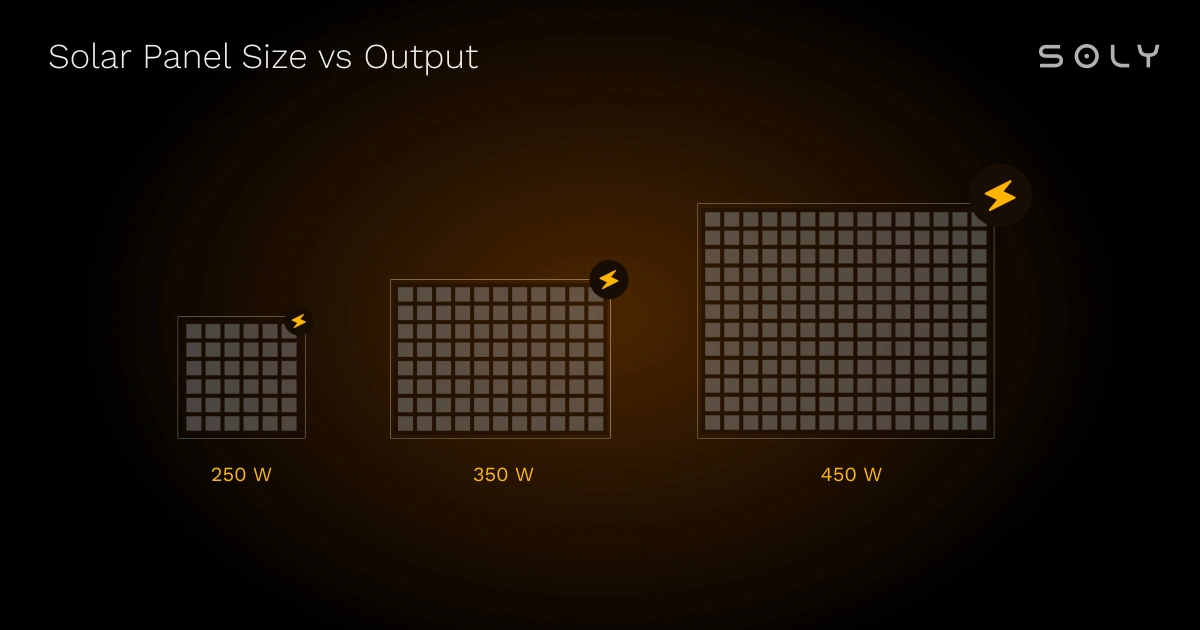
For residential setups in the UK, most solar PV systems range between 2kWp to 5kWp. This usually involves around 6 to 14 panels. It’s ideal for most homes because it provides a good amount of power without taking up too much room on your roof.
Below, we’ll put the wattage calculation formula for your solar panel needs:
Here’s how to calculate your solar panel dimension needs using the wattage calculation formula:
- Understand your energy usage: Check your electricity bill to see how much energy you use in a year (measured in kilowatt-hours or kWh). For example, a small home might use around 1,800 kWh a year, while a larger one could need more than 4,000 kWh. This number helps you figure out how big your solar system needs to be.
- Determine the number of solar panels you need: To calculate the number of solar panels, divide your annual energy usage by the power output of a single panel. For instance, if your home uses 3,600 kWh per year and each panel generates 300 watts (0.3kW), you would need about 12 panels (because 3,600 ÷ 300 = 12). This ensures your solar system will produce enough energy to cover your electricity needs.
- Consider your roof space: Measure your roof to see how many panels can fit. The size of your roof will impact the number and size of the panels you can install. A small 3.5kWp system usually requires about 20 square metres of space, while a larger 5kWp system needs around 28 square metres. Make sure your roof can fit the number of panels you need to generate the energy you want.
Calculations do not end with wattage.
With Soly, you can calculate the yield of your solar panels using our online configurator. This handy solar panel savings calculator lets you know exactly how much solar energy your panels produce on sunny and cloudy days.
Solar panel physical dimensions
As we touched on earlier, solar panels will come in various sizes and their physical dimensions will depend on the type of solar cell technology used:
- For residential UK homes, the average solar panel size is generally between 1.6 to 1.8 metres tall and around 1 metre wide. These panels typically produce between 250 to 450 watts, with a common 350-watt panel measuring 1.7 metres by 1 metre, covering 1.7 square metres on a roof. However, some newer panels exceed this 450W, especially for high-efficiency models.
- Commercial solar panels, on the other hand, are much larger and far more powerful, designed to meet the higher energy demands of commercial buildings. Commercial panels typically have a power output of 400 to 600 watts. Their dimensions are often around 1.95 metres long and 1 metre wide, covering 1.95 square metres per panel.
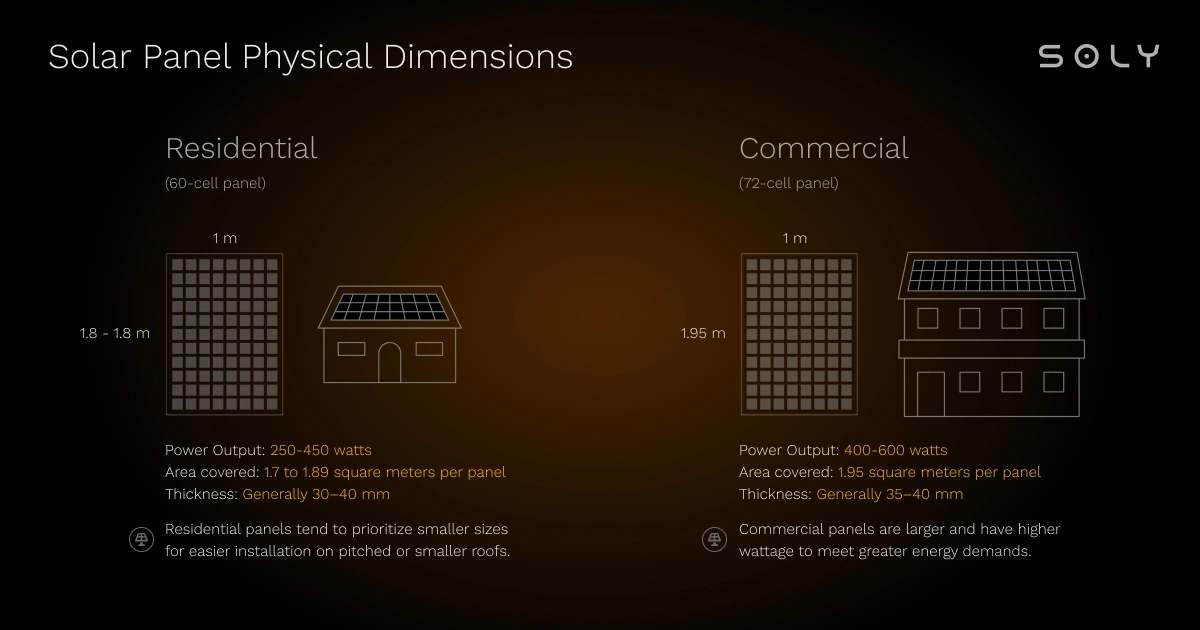
In some cases, larger panels (exceeding 2 metres in length) may be used for commercial buildings with more available roof space, to meet greater energy needs efficiently.
Takeaways for residential and commercial solar panel dimensions:
- Commercial panels are larger and have higher wattage to meet greater energy demands.
- Residential panels tend to prioritize smaller sizes for easier installation on pitched or smaller roofs.
Choosing the correct solar panel size is essential for maximising your roof space and ensuring that your solar system meets your energy needs more efficiently. That’s why it’s equally important to look at other key differences in the physical dimensions of solar panels.
Key differences between solar panel types:
- Monocrystalline panels: These panels are known for their high efficiency and compact solar panel size. They are a great choice if you have a smaller roof because they generate more power per square metre. This means you can get more energy from a smaller number of panels.
- Polycrystalline panels: Polycrystalline solar panels, produced from multiple small silicon crystals, are typically more affordable than monocrystalline options. They come in various sizes suitable for both homes and businesses with ample roof space, allowing for more panels to meet energy needs without compromising power generation. With high efficiency ratings, they are a popular choice for installations where budget and space are key considerations.
- Thin-film panels: Although these panels are less efficient, they are lightweight and flexible, which can be advantageous for certain installations. They’re often used for large commercial roofs or unconventional mounting situations where traditional panels might not fit or be practical.
Keep on reading:
– Polycrystalline vs. Monocrystalline solar panels: What’s best?
– All types of solar panels explained
Solar panel weight
When considering solar panel dimensions, weight can vary based on their solar panel size and type.
For residential installations in the UK, panels generally weigh between 18-21 kg each. Commercial PV panels tend to be heavier and range anywhere between 22-30 kg.
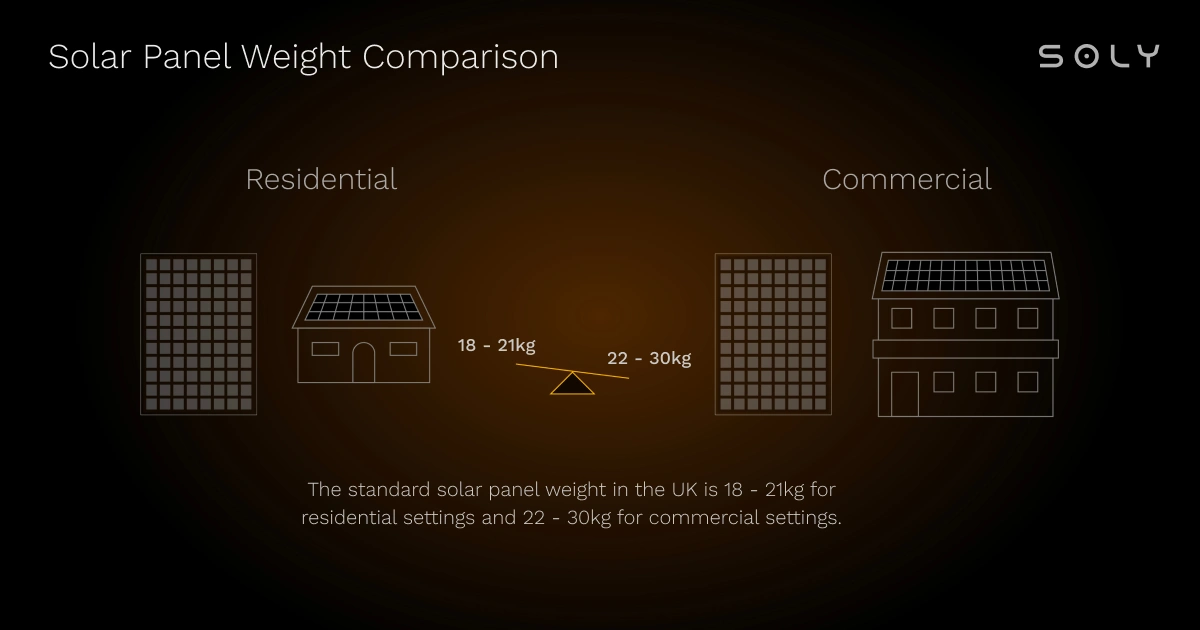
Although this may sound substantial, most roofs can handle a load like this. However, it’s wise to have your roof’s structure checked out by a professional before installation to ensure it can handle additional weight.
Proper assessment and preparation is key for a successful solar installation.
If your roof can’t handle the weight of the panels, additional reinforcement may be required. In any case, a professional solar panel installer will be able to evaluate your roof and recommend any necessary upgrades to ensure a safe and effective install process.
Why PV panel size matters
When choosing your solar panel system, the solar panel size play an important role in determining the amount of energy you can produce, the overall efficiency of your solar panel setup, and how well it fits within your available roof space. Here’s a few reasons why PV panel size matters:
- The larger the panel, the more solar cells it can contain, allowing it to produce more electricity. However, larger panels don’t automatically mean better performance. High-efficiency panels, like monocrystalline solar panels, can deliver significant energy in a smaller footprint. In contrast, polycrystalline and thin-film panels may require more space to generate the same amount of power.
- Your roof’s size and shape will directly impact how many panels you can install. For instance, residential solar panels typically range from 1.7m x 1m to 2m x 1m, which means even a modest roof can accommodate a 3-4kW system. On the other hand, commercial setups have more flexibility for larger panels, some reaching up to 3.5m
- Larger panels reduce unit needs but are heavier and harder to install. For a typical residential installation, panels usually weigh between 18-21 kg, which is manageable with proper support. Commercial panels, however, can weigh up to 30 kg, requiring additional structural assessments
- Your energy goals determine whether to prioritise solar panel size or output. If your roof space is limited, opting for high-efficiency panels with a smaller physical footprint may be the best option. Conversely, if space isn’t an issue, larger panels with moderate efficiency could be more cost-effective
Solar panel size chart
Over the past decade, we have seen the cost of solar panels drop by more than 80%.
This has made them more affordable than ever to many homeowners and businesses. This significant price reduction is thanks to the many advancements in technology and the increased production efficiency and greater competition in the solar market.
Despite the initial investment, solar panels can offer significant savings on your electric bills over time and help to reduce your carbon footprint.
This makes them a smart choice.
Standard solar panel sizes in the UK: Examples on how many solar panels you may need
In this section, we’re going to provide a quick overview of the standard solar panel sizes and what they mean for your installation. These are based on whether they’re intended for residential or commercial use.
Residential solar panels:
- Dimensions: The most common residential panels range from 1.6m x 1m to 1.8m x 1m, with a thickness of about 3.99 cm (3-5 cm).
- Power output: These panels typically generate between 250W and 450W. Higher-wattage panels mean fewer panels are needed to meet your energy requirements.
- Number of panels: For an average UK household, a 3.5kWp system—suitable for 3 bedrooms—requires around 10 panels.
Commercial solar panels:
- Dimensions: Commercial panels are generally larger, with sizes reaching up to 2m x 1m to 3.5m x 2m. This allows businesses to meet higher energy demands
- Power output: Typically, commercial panels offer between 400W and 600W per panel, optimising large roof spaces for maximum energy production
- Number of panels: Depending on the system size and energy needs, commercial setups can include dozens of panels, providing energy for high-demand operations like manufacturing or office buildings.
Keep on reading: How many solar panels do I need? – 2 ways to calculate
Roof space requirements:
To give you a better idea, here’s an estimate of the roof space needed based on standard solar panel sizes:
- 2kWp System: Requires around 12m².
- 3.5kWp System: Takes up approximately 20m².
- 5kWp System: Needs about 28m².
The key to choosing the right solar panel size lies in balancing available roof space, energy needs, and budget. Larger panels can generate more power but may be harder to install and cost more upfront. On the other hand, smaller, high-efficiency panels might be the better choice for limited roof space.
How to choose the right solar panel size for your needs
Choosing the right solar panel size is going to involve balancing energy needs, available space, and budget. Here’s how to get started:
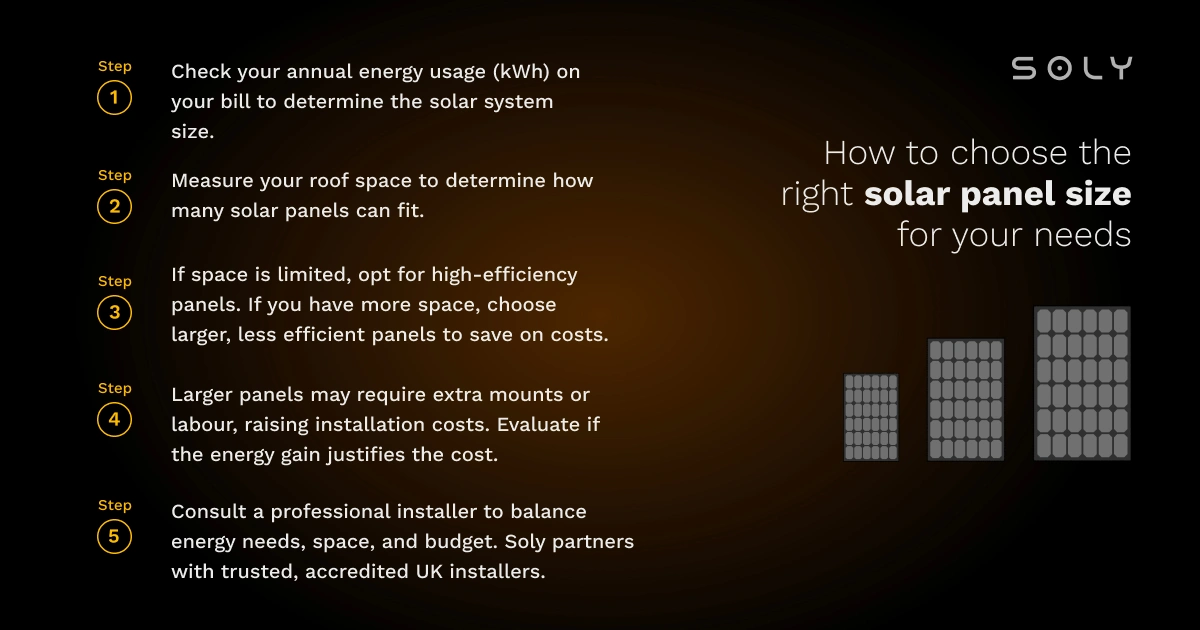
1. Assess your yearly energy usage (in kWh):
Begin by looking at your household or business’s annual energy consumption. You can find this information on your energy bill and it will help you decide the size of a solar PV system you need to meet your energy needs.
For example:
- A small home with 1-2 bedrooms may consume around 1,800 kWh per year, requiring a 2kWp system with 6 panels.
- Larger homes with 4-5 bedrooms, with a yearly energy consumption of ~4100kWh, may need a 5kWp system, which typically requires 14 panels.
2. Evaluate available roof space
When it comes to solar panel sizes, measure your roof to see how much space you have for installing solar panels. Keep in mind:
- For a 3.5kWp system (suitable for small homes), you’ll need around 20m² of roof space.
- A 5kWp system requires approximately 28m²
3. Choose between efficiency and size
If your roof is limited, go for high-efficiency panels like monocrystalline panels that produce more power per square metre. If you have more space, you can use larger, less efficient panels to save on initial costs.
4. Factor in installation costs
Larger solar panel dimensions may require special mounting systems or additional labour. This can increase the cost of installation. Be sure to consider if the increased energy output justifies the higher installation costs:
- High-efficiency panels are more compact but often come at a premium price.
- Larger, standard-efficiency panels might be more affordable initially but could result in higher installation costs due to their size and weight.
5. Consult a professional installer
At Soly, we only work with trusted, local, accredited installers. We believe it’s best to work with professional installers as they will balance your energy needs, roof space, and budget. At Soly, we’re a Which? Trusted Trader, and our installers across the UK are accredited by HIES, TrustMark, and MCS. They’re ready to assist you in any way when it comes to a professional-grade installation.
Frequently Asked Questions
How big are solar panels?
Solar panels come in many sizes. Residential solar panels are usually around 1.6 to 2 metres tall and 1 metre wide.
Are bigger solar panels better?
Not necessarily. Solar panels with bigger dimensions may produce more power but may not always be the best fit depending on your roof space and energy needs.
How heavy are solar panels?
Panels weight will vary by size and type. Residential solar panels generally weigh between 18-25 kg.
What size of solar panels do I need for my home?
This will depend on the amount of energy you use and your needs. You can use our online configurator to estimate the size, cost, and yield for your home.
What is the typical size of a solar panel?
Solar panel dimensions will vary depending on the type and manufacturer.
What are the dimensions of a typical solar panel?
The physical dimensions of most standard commercial panels are usually around 77 by 39 inches, with a thickness of around 1.5 inches.
Final thoughts
When it comes to solar panel dimensions, it’s all about choosing the right solar panel size. You need adequate roof space, total power output, and to be sure your roof can handle the weight of the panels. It’s important to research your options and work with a trusted solar expert like Soly. We will help you find the best solution for your energy needs in the UK.
Why choose Soly as your solar partner in the UK?
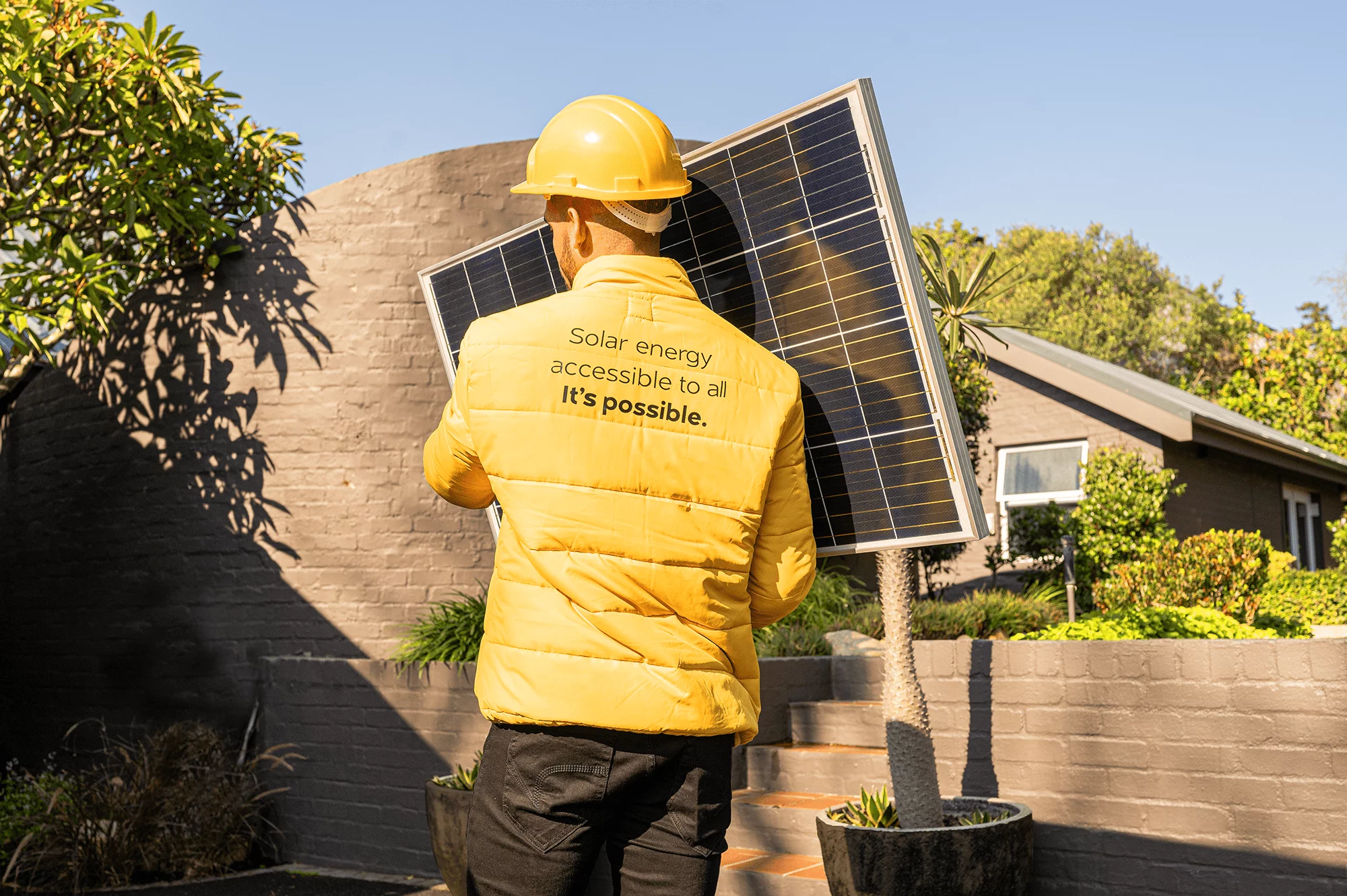
As solar experts, we provide assistance with nationwide installations across the UK. We’re backed with over ten years of experience and committed to delivering on quality.
Allow Soly to to be your partner in solar with our:
- Online configurator: Get an instant estimate of potential savings with our easy-to-use tool.
- Free consultation: Schedule a no-cost consultation with our solar experts for advice tailored to your needs.
- Quick quote: Receive a fast, no-obligation quote after your consultation.
- Hassle-free installation: Our certified, trusted, and HIES accredited installers will handle everything for a safe and professional installation.
At Soly, we’ve earned a 4.7-star rating on TrustPilot and are recognised as a Which? Trusted Trader.
With over 800,000 systems installed and over 35,000 happy customers, we have over 10 years of experience in the field as solar experts. Choosing the right solar panel size is just one part of the process, and we’re here to help guide you through the rest.
Get in touch with Soly today and allow us to make your journey with solar simple and efficient, with solar panels that provide you with long-lasting energy and up to 25-year guarantees.